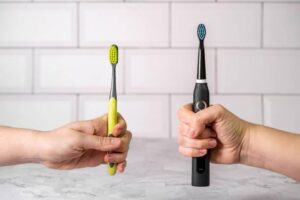Orthodontics is a specialized field of dentistry that focuses on diagnosing, preventing, and correcting misaligned teeth and jaws. While many people associate orthodontics with braces, the field encompasses a wide range of treatments designed to create healthy, functional, and aesthetically pleasing smiles. This blog will explore what orthodontics entails, the benefits of treatment, the different types of orthodontic appliances, and how to determine if you or your child might need orthodontic care.
What Is Orthodontics?
Orthodontics is the branch of dentistry that addresses the alignment of teeth and jaws. The primary goal of orthodontic treatment is to correct malocclusions, or “bad bites,” which occur when the teeth are not correctly aligned. Malocclusions can result from various factors, including genetics, thumb-sucking during childhood, or premature loss of baby teeth.
Orthodontic treatment can improve not only the appearance of your smile but also the function of your teeth and jaws. Misaligned teeth can lead to problems with chewing, speaking, and maintaining oral hygiene. Left untreated, malocclusions can contribute to tooth decay, gum disease, and even temporomandibular joint (TMJ) disorders.
Common Orthodontic Issues
There are several types of malocclusions that orthodontists commonly treat:
- Crowded Teeth: When there isn’t enough space in the mouth for all the teeth to fit properly, they may overlap or become twisted.
- Overbite: This occurs when the upper front teeth overlap significantly with the lower front teeth.
- Underbite: The lower front teeth protrude past the upper front teeth, often giving the chin a more prominent appearance.
- Crossbite: Some upper teeth sit inside the lower teeth when the mouth is closed, which can cause wear and tear on the teeth.
- Open Bite: There’s a gap between the upper and lower front teeth when the mouth is closed, often resulting from thumb-sucking or tongue thrusting.
- Spacing: Gaps between teeth can result from missing teeth or teeth that don’t fill the mouth.
The Benefits of Orthodontic Treatment
Orthodontic treatment offers numerous benefits, extending beyond just a beautiful smile:
- Improved Oral Health: Straight teeth are easier to clean, reducing the risk of cavities and gum disease.
- Enhanced Functionality: Properly aligned teeth and jaws make it easier to chew, speak, and bite, leading to overall better oral function.
- Prevention of Future Issues: Correcting misalignment early on can prevent more severe problems from developing later in life, such as tooth wear, TMJ disorders, and difficulty in maintaining oral hygiene.
- Boosted Self-Confidence: A straighter smile can significantly improve self-esteem, particularly in social and professional situations.
- Better Jaw Alignment: Proper jaw alignment can reduce the risk of TMJ disorders and alleviate symptoms like jaw pain, headaches, and neck pain.
Types of Orthodontic Appliances
Orthodontic treatments aren’t one-size-fits-all. Several types of appliances can be used depending on the specific needs of the patient:
- Traditional Metal Braces: These are the most common and recognizable type of orthodontic appliance. Metal brackets are attached to the teeth and connected by wires that are periodically tightened to gradually shift the teeth into their correct positions.
- Ceramic Braces: Similar to metal braces but with brackets made of tooth-colored ceramic, these braces are less noticeable and offer a more aesthetic option for patients concerned about appearance.
- Lingual Braces: These braces are similar to traditional metal braces, but they are attached to the back (lingual side) of the teeth, making them invisible from the front.
- Clear Aligners: A popular alternative to traditional braces, clear aligners like Invisalign are custom-made plastic trays that fit over the teeth and gradually move them into the desired position. They are nearly invisible, removable, and easier to clean.
- Retainers: After orthodontic treatment, retainers are used to maintain the new position of the teeth. They can be either removable or fixed, depending on the patient’s needs.
- Palatal Expanders: These devices are used primarily in children to widen the upper jaw, allowing for better alignment of the upper and lower teeth.
When to Seek Orthodontic Care
It’s essential to know when to seek orthodontic care, whether for yourself or your child. The American Association of Orthodontists recommends that children have their first orthodontic evaluation by age seven. At this age, an orthodontist can identify potential issues and determine if early intervention is necessary.
However, orthodontic treatment is not just for children and teenagers. Many adults seek orthodontic care to correct long-standing issues or improve their smile. With advancements in technology, adult orthodontic treatment has become more accessible, comfortable, and discreet.
Signs that you or your child might need orthodontic care include:
- Difficulty chewing or biting
- Speech difficulties
- Crowded or overlapping teeth
- Protruding teeth
- Frequent biting of the cheeks or tongue
- Jaw pain or clicking
- Teeth that don’t meet correctly when the mouth is closed
If you’re unsure whether orthodontic treatment is necessary, schedule a consultation at Fernandez, DMD and we will determine if an orthodontist is a good step for you. If you are referred to an orthodontist, you can expect a thorough examination, which may include X-rays and photographs, to determine the best course of action.
The Orthodontic Treatment Process
Orthodontic treatment typically involves several stages:
- Consultation and Evaluation: The orthodontist will assess the patient’s teeth, jaws, and facial structure. X-rays, photographs, and impressions may be taken to help the orthodontist create a personalized treatment plan.
- Treatment Planning: Based on the evaluation, the orthodontist will develop a treatment plan tailored to the patient’s needs. This plan will outline the type of appliances to be used, the estimated duration of treatment, and the expected outcome.
- Active Treatment: This is the stage where the orthodontic appliances are placed, and adjustments are made over time to move the teeth into their correct positions. Regular visits to the orthodontist are necessary to monitor progress and make adjustments.
- Retention: Once the active treatment phase is complete, a retainer will be used to maintain the new position of the teeth. Retainers are typically worn full-time initially, then gradually reduced to nighttime wear.
- Follow-Up: Regular follow-up visits ensure that the teeth remain in their correct positions and that no further treatment is needed.
The Importance of Choosing the Right Orthodontist
Choosing the right orthodontist is crucial to achieving the best possible outcome. It’s important to select a professional with experience, a good reputation, and a commitment to patient care. At Fernandez, DMD, we pride ourselves on providing excellent dental care, and when necessary, refer our patients to the appropriate orthodontist who will properly and efficiently treat their orthodontic needs.
Our team is dedicated to helping you achieve the smile of your dreams through personalized care and state-of-the-art treatment options. We understand that every patient is unique, and we work closely with you to create a treatment plan that meets your specific needs and goals.
If you or your child are in need of orthodontic care, don’t hesitate to take the first step toward a healthier, more confident smile. At Fernandez, DMD, we offer comprehensive dental services for patients of all ages.
Visit us at 502 E. Olympia Ave., Punta Gorda, FL 33950, or give us a call at 941-639-1124 to schedule your consultation today. Our team is here to guide you through every step of your orthodontic journey, ensuring a positive and successful experience. Let us help you achieve the smile you’ve always wanted!





